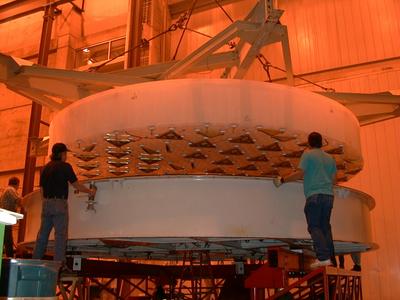
Mirror, Mirror
By Dennis Overbye
The New York Times
8-30-05
TUCSON - In the cavernous bowels of the University of Arizona's football stadium, Roger Angel's mirror furnace was spinning like a captured flying saucer at a stately five revolutions per minute.By Dennis Overbye
The New York Times
8-30-05
It was a contrivance that Monty Python or Doc Ock might have designed - 30 feet across and 10 feet high, carapaced with red boxes, steel beams, black cables, flashing lights and metal air ducts snaking from its body like octopus arms.
An orange glow, from 18 tons of molten glass heated to 2,100 degrees Fahrenheit, was peeking through openings around the ducts as they flashed by.
That glass was on its way to being part of the heart of what could be the largest telescope in the world 10 years from now. And so, nearby, several dozen sweltering astronomers and other dignitaries were roaming catwalks, wandering among giant mirrors and mirror polishing machines and swigging bottled water while they kept a weather eye on monitors showing what was going on inside the furnace.
One camera was focused on a set of marks on the furnace wall - not unlike the ones on a child's closet door - used to gauge the level of the molten glass inside. The level had been falling in the last day as the temperature ramped up and chunks of glass the size of cobblestones softened and began to flow down into narrow channels forming a honeycomb pattern.
The glass would stop falling when it had completely filled the honeycomb structure. Meanwhile, centrifugal force would have whipped the overflow into a perfect parabola 28 feet across - the desired shape for sweeping up starlight dispersed into foggy invisibility over billions of light-years and compressing it into crisp bright dots astronomers could read like a newspaper to learn what was happening around a distant sun or when the universe was born.
That was the moment the real work could begin.
"This project is very gutsy," said Dr. Angel, a slender, gray-haired astronomer who runs the Steward Observatory Mirror Laboratory. He has been building mirrors and populating mountaintops with telescopes this way for 20 years, but nobody has ever built something like this.
If everything works out, the mirror now forming in Dr. Angel's saucerlike furnace will be only the first of seven making up a giant telescope with the light-gathering power of a mirror 70 feet across. The Giant Magellan, as it is called, would be twice the size of anything now operating on Earth or in space, and four times as powerful. But there are many challenges. To blend their light at a common focus, Dr. Angel explained, all seven mirrors will have to be part of the same giant parabola. That means that all of them except the central mirror must have an unusual "wickedly curved" asymmetrical shape.
And there is the cost. The Giant Magellan will cost half a billion dollars - money that its collaborators, a consortium of eight institutions, does not yet have.
To show that they can make such a mirror, and perhaps shake loose some of that half billion, the collaborators - which include the Carnegie Institution of Washington; Harvard; the Massachusetts Institute of Technology; the Smithsonian Astrophysical Observatory; the Universities of Arizona, Michigan and Texas; and Texas A&M - announced this year that they would go ahead and make one, at a cost of some $17 million, and they invited everyone to watch.
"Everybody in collaboration believes we need to test this technology," said Wendy Freedman, director of the Carnegie Observatories and chairwoman of the Giant Magellan board, adding that if the test fails the project will not proceed.
Robert Kirshner of Harvard said, "It's kind of brave to get started before you know you're going to finish."
Dr. Freedman added that they had to start making mirrors now, money or not, to meet their goal of beginning limited operations in Chile in 2013 and finish in 2016.
Making that date will allow them to overlap with the National Aeronautics and Space Administration's James Webb Space Telescope, scheduled for a 2011 launching and keep pace with their rivals, a consortium including the California Institute of Technology, the University of California and the Canadian Astronomical Association that wants to build a telescope 100 feet in diameter, using a radically different technology.
More . . .
Home
No comments :
Post a Comment
Dear Reader/Contributor,
Your input is greatly appreciated, and coveted; however, blatant mis-use of this site's bandwidth will not be tolerated (e.g., SPAM, non-related links, etc).
Additionally, healthy debate is invited; however, ad hominem and or vitriolic attacks will not be published, nor will "anonymous" criticisms. Please keep your arguments/comments to the issues and subject matter of this article and present them with civility and proper decorum. -FW